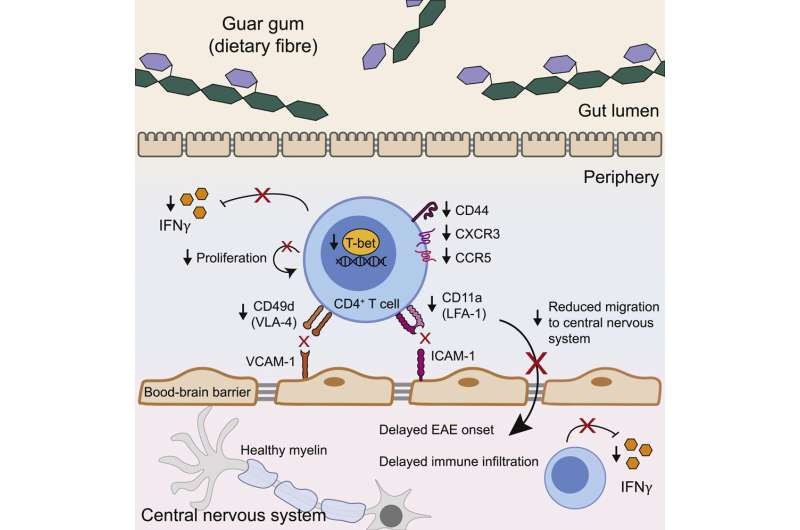Diet high in guar gum fiber limits inflammation and delays multiple sclerosis symptoms in mice

Diets high in guar gum, a common food additive and dietary fiber, limit inflammation and delayed the onset of multiple sclerosis (MS) symptoms in mice, according to new research by members of the University of British Columbia (UBC) Microbiology and Immunology department. The team's findings were published in Cell Reports.
"The rapid increase of autoimmune and inflammatory disorders in industrialized countries in the last few decades indicates dietary choices are one environmental factor contributing to incidence," said Dr. Lisa Osborne, senior researcher on the study and an assistant professor with UBC Microbiology and Immunology.
"Dietary fibers are potent modulators of immune responses and can control inflammation in multiple diseases, but they're a very biochemically diverse family. Our study gives us a clearer window into the potential of several sources of fiber in maintaining immune health."
Dr. Osborne and colleagues exposed groups of mice to a variety of diets—a control 5% cellulose fiber diet, a diet entirely lacking in dietary fiber, or diets enriched (30%) with fiber in either resistant starch, inulin, pectin, or guar gum. Guar gum was the only fiber type that significantly limited the MS-like symptoms.
Guar gum—guaran—is extracted from guar beans, and is often used as an additive to thicken and stabilize food and animal feed, and in industrial applications. India and Pakistan are major growers of the bean.
"Guar beans aren't that common in western diets, and the gum isn't used at these high levels as an additive in the west," says Naomi Fettig, first author on the study and a Ph.D. student with the Department of Microbiology and Immunology at UBC.
"Experts have consistently been saying fiber is good for you—and a variety of fiber sources is important to immune health—but there hasn't been very much critical work into identifying how the body responds to different fiber types. It's fascinating that this particular source has such an impact."
In the US and Canada, the average daily intake of fiber is 15 grams—current recommendations are double that at 30 grams. The recommended values don't take into account any specific fiber type. "Incorporating guar beans might be challenging to achieve at the doses we gave to mice," says Dr. Osborne. "But a guar gum derivative, partially hydrolyzed guar gum, is commercially available as a prebiotic."
After the gum is broken down by the microbiota of mice, the resulting molecules appear to reduce the activity and proliferation of a type of CD4+ T cells, Th1 cells, that play a key part in activating the autoimmune response. It's that response that leads to MS-like symptoms in mice. The effects of fiber on Th1 cells were largely unknown prior to this study, and these findings suggest that the biochemical differences in fiber structures can influence diverse immune pathways.
Dr. Osborne and her lab now want to explore the potential benefits in humans—including developing a more detailed understanding of the molecular picture, which might help design therapeutics that offer the benefits of such high guar gum diets in a more practical form.
More information: Naomi M. Fettig et al, Inhibition of Th1 activation and differentiation by dietary guar gum ameliorates experimental autoimmune encephalomyelitis, Cell Reports (2022). DOI: 10.1016/j.celrep.2022.111328


















